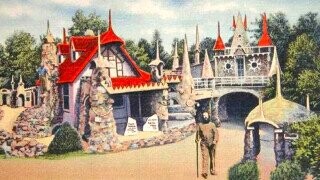The Rise And Fall Of New Jersey's 'Palace Of Depression' Theme Park

Early mental health advocate or just an eccentric man who wanted attention? Comparingly the Joe Exotic of the 1930s (minus the tigers), George Daynor built his own empire he deemed "The Palace of Depression," right after the 1930's market crash to prove to the public that "the depression was not impossible to overcome."

Don't Miss
His self-prescribed motto- "the only real depression is a depression of individual ingenuity," because we know that's just how things work. Living off of his land, at times eating frogs and squirrels like a baby Yoda, he constructed his palace over a swamp.

Believing he was God's gift to Earth, Daynor walked 10 miles in search of land to purchase with only $7 and a dream in his pocket, eventually finding a junkyard he could afford in Vineland, New Jersey. Daynor claimed to have been guided by an angel, suggesting he should create this "Palace of Depression" with his natural resources and findings of the junkyard, including mud, bed frames, bottles, old steering wheels … you know, all the essentials to build a house.
Visitors from across the world came to witness the "genius" at hand for his grand opening in 1932. One great attraction was the knockout room where one could willingly have a hefty object fall onto their head if they were trying to forget something unpleasant (like maybe their visit there).
Daynor's delusion led to him proclaiming the palace as "the greatest piece of originality ever brought about in the history of man," while others referred to it as the "Home of Junk" And with zero endorsements by anyone, Daynor claimed to be "the most photographed man in the world."
Known for his love of media attention, he would do anything to catch the eyes of the public. During the 1950s, authorities searched for the culprit of the Weinberger child kidnapping, and Daynor, seeing his opportunity, told the FBI that the kidnapper had previously visited his palace. Obviously not the truth, but an attention-seeking device gone wrong, Daynor was placed in jail for a few years.
After trying to convince the Smithsonian that the "closest point to China was in Vineland" and inquiring about donating his brain to the well-renowned museum, he was asked to leave promptly. He also declared that the Cuban government stole money that he'd won in the Cuban National Lottery, all 1 million pesos. It was claimed that the money was later hijacked near the Waldorf Hotel in New York. Later, the Waterman Pen company denied Draynor's request to feature the palace in their famous ads after he'd told them that thousands of his visitors used those pens to sign into his wondrous world. Oh, and Draynor locked up his common-law wife in the palace's ticket booth during palace showings; she later left him, obviously.
Daynor lived to be 104 years old, with no money toward the end of his century, buried in Vineland at Oak Hill cemetery with no known relatives. Soon after his death in 1964, the palace was mysteriously burnt down and bulldozed over five years later. Now, it is possible to visit the site, as there has been an effort to rebuild it. This time without a knockout room, hopefully.
For more of Oona’s sarcasm and attempted wit, visit her website oonaoffthecuff.com.
Top Image: Boston Public Library
